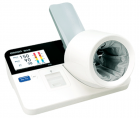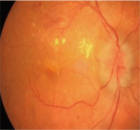Abstract
Research Article
Validation of the Omron HBP-9031C blood pressure monitor for clinics and hospitals according to the ANSI/AAMI/ISO 81060-2:2013 protocol
Hakuo Takahashi*, Kanako Saito and Yukiko Hishiki
Published: 13 August, 2019 | Volume 3 - Issue 1 | Pages: 043-046
Objective: The present study aimed to evaluate the accuracy of the Omron HBP-9031C automated oscillometric upper-arm blood pressure (BP) measurement device for blood pressure monitoring, according to the ANSI/AAMI/ISO 81060-2:2013 protocol (ANSI/AAMI/ISO).
Participants and Method: The device evaluations were performed in 85 participants, who fulfilled the inclusion criteria of the protocol. The validation procedure and data analysis followed the protocol precisely.
Results: In the ANSI/AAMI/ISO 81060-2-2013 validation procedure (criterion 1), the mean ± SD of the differences between the test device and reference BP was 0.5 ± 7.84/-1.9 ± 6.30 mmHg (systolic/diastolic). The mean differences between the two observers and the Omron HBP-9031C were 0.5 ± 6.69 mmHg (range, −18 to 15 mmHg) for systolic BP and -1.9 ± 5.63 mmHg (range, −17 to 14 mmHg) for diastolic BP, according to criterion 2. The two criteria of the ANSI/AAMI/ISO were fulfilled.
Conclusion: The professional OMRON BP monitor, HBP-9031C fulfilled the requirements of the ANSI/AAMI/ISO validation standard and can be recommended for clinical use.
Read Full Article HTML DOI: 10.29328/journal.ach.1001018 Cite this Article Read Full Article PDF
Keywords:
Blood pressure monitoring device; Validation study; International Protocol
References
- Ikeda N, Inoue M, Iso H, Ikeda S, Satoh T, et al. Adult mortality attributable to preventable risk factors for non-communicable diseases and injuries in Japan: a comparative risk assessment. PLoS Med. 2012; 9: e1001160. PubMed: https://www.ncbi.nlm.nih.gov/pubmed/22291576
- Zhang Y, Agnoletti D, Blacher J, Safar ME. Blood pressure variability in relation to autonomic nervous system dysregulation: the X-CELLENT study. Hypertens Res. 2012; 35: 399-403. PubMed: https://www.ncbi.nlm.nih.gov/pubmed/22129516
- O'Brien E, Dolan E, Stergiou GS. Achieving reliable blood pressure measurements in clinical practice: It's time to meet the challenge. J Clin Hypertens (Greenwich). 2018; 20: 1084-1088. PubMed: https://www.ncbi.nlm.nih.gov/pubmed/30003700
- SPRINT Research Group, Wright JT Jr, Williamson JD, Whelton PK, Snyder JK, et al. A Randomized Trial of Intensive versus Standard Blood-Pressure Control. N Engl J Med. 2015; 373: 2103-2116.
- Roerecke M, Kaczorowski J, Myers MG. Comparing Automated Office Blood Pressure Readings with Other Methods of Blood Pressure Measurement for Identifying Patients With Possible Hypertension: A Systematic Review and Meta-analysis. JAMA Intern Med. 2019; 179: 351-362. PubMed: https://www.ncbi.nlm.nih.gov/pubmed/30715088
- Association for the Advancement of Medical Instrumentation American National Standard. ANSI/AAMI/ISO 81060-2:2013 Non-invasive Sphygmomanometers - Part 2: Clinical investigation of automated measurement type. 2019.
- Stergiou GS, Alpert B, Mieke S, Asmar R, Atkins N, et al. A universal standard for the validation of blood pressure measuring devices: Association for the Advancement of Medical Instrumentation/European Society of Hypertension/International Organization for Standardization (AAMI/ESH/ISO) Collaboration Statement. J Hypertens. 2018; 36: 472-478. PubMed: https://www.ncbi.nlm.nih.gov/pubmed/29384983
Figures:

Figure 1

Figure 2
Similar Articles
Recently Viewed
-
Sinonasal Myxoma Extending into the Orbit in a 4-Year Old: A Case PresentationJulian A Purrinos*, Ramzi Younis. Sinonasal Myxoma Extending into the Orbit in a 4-Year Old: A Case Presentation. Arch Case Rep. 2024: doi: 10.29328/journal.acr.1001099; 8: 075-077
-
The relationship between IT consumption and anxiety in Pakistani youthWaqar Husain*,Sehrish Mobeen. The relationship between IT consumption and anxiety in Pakistani youth. Arch Psychiatr Ment Health. 2020: doi: 10.29328/journal.apmh.1001026; 4: 084-086
-
A Gecko-eye View of Naturalistic EnclosuresVictoria Davies, Abigail Heaman, James Brereton*. A Gecko-eye View of Naturalistic Enclosures. Insights Biol Med. 2023: doi: 10.29328/journal.ibm.1001026; 7: 013-019
-
Success, Survival and Prognostic Factors in Implant Prosthesis: Experimental StudyEpifania Ettore*, Pietrantonio Maria, Christian Nunziata, Ausiello Pietro. Success, Survival and Prognostic Factors in Implant Prosthesis: Experimental Study. J Oral Health Craniofac Sci. 2023: doi: 10.29328/journal.johcs.1001045; 8: 024-028
-
Bleeding from Varices: Still a Heavy Burden in Patients with CirrhosisAmitrano L*, Guardascione MA, Saviano S, Martino A, Lombardi G. Bleeding from Varices: Still a Heavy Burden in Patients with Cirrhosis. Ann Clin Gastroenterol Hepatol. 2023: doi: 10.29328/journal.acgh.1001043; 7: 035-037
Most Viewed
-
Evaluation of Biostimulants Based on Recovered Protein Hydrolysates from Animal By-products as Plant Growth EnhancersH Pérez-Aguilar*, M Lacruz-Asaro, F Arán-Ais. Evaluation of Biostimulants Based on Recovered Protein Hydrolysates from Animal By-products as Plant Growth Enhancers. J Plant Sci Phytopathol. 2023 doi: 10.29328/journal.jpsp.1001104; 7: 042-047
-
Sinonasal Myxoma Extending into the Orbit in a 4-Year Old: A Case PresentationJulian A Purrinos*, Ramzi Younis. Sinonasal Myxoma Extending into the Orbit in a 4-Year Old: A Case Presentation. Arch Case Rep. 2024 doi: 10.29328/journal.acr.1001099; 8: 075-077
-
Feasibility study of magnetic sensing for detecting single-neuron action potentialsDenis Tonini,Kai Wu,Renata Saha,Jian-Ping Wang*. Feasibility study of magnetic sensing for detecting single-neuron action potentials. Ann Biomed Sci Eng. 2022 doi: 10.29328/journal.abse.1001018; 6: 019-029
-
Pediatric Dysgerminoma: Unveiling a Rare Ovarian TumorFaten Limaiem*, Khalil Saffar, Ahmed Halouani. Pediatric Dysgerminoma: Unveiling a Rare Ovarian Tumor. Arch Case Rep. 2024 doi: 10.29328/journal.acr.1001087; 8: 010-013
-
Physical activity can change the physiological and psychological circumstances during COVID-19 pandemic: A narrative reviewKhashayar Maroufi*. Physical activity can change the physiological and psychological circumstances during COVID-19 pandemic: A narrative review. J Sports Med Ther. 2021 doi: 10.29328/journal.jsmt.1001051; 6: 001-007

HSPI: We're glad you're here. Please click "create a new Query" if you are a new visitor to our website and need further information from us.
If you are already a member of our network and need to keep track of any developments regarding a question you have already submitted, click "take me to my Query."














































































































































